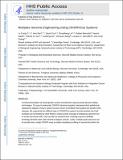| dc.contributor.author | Cong, Le | |
| dc.contributor.author | Ran, F. Ann | |
| dc.contributor.author | Cox, David Daniel | |
| dc.contributor.author | Lin, Shuailiang | |
| dc.contributor.author | Barretto, Robert | |
| dc.contributor.author | Habib, Naomi | |
| dc.contributor.author | Hsu, Patrick | |
| dc.contributor.author | Wu, Xuebing | |
| dc.contributor.author | Jiang, Wenyan | |
| dc.contributor.author | Marraffini, Luciano A. | |
| dc.contributor.author | Zhang, Feng | |
| dc.date.accessioned | 2016-05-25T20:07:00Z | |
| dc.date.available | 2016-05-25T20:07:00Z | |
| dc.date.issued | 2013-02 | |
| dc.identifier.issn | 0036-8075 | |
| dc.identifier.issn | 1095-9203 | |
| dc.identifier.uri | http://hdl.handle.net/1721.1/102687 | |
| dc.description.abstract | Functional elucidation of causal genetic variants and elements requires precise genome editing technologies. The type II prokaryotic CRISPR (clustered regularly interspaced short palindromic repeats)/Cas adaptive immune system has been shown to facilitate RNA-guided site-specific DNA cleavage. We engineered two different type II CRISPR/Cas systems and demonstrate that Cas9 nucleases can be directed by short RNAs to induce precise cleavage at endogenous genomic loci in human and mouse cells. Cas9 can also be converted into a nicking enzyme to facilitate homology-directed repair with minimal mutagenic activity. Lastly, multiple guide sequences can be encoded into a single CRISPR array to enable simultaneous editing of several sites within the mammalian genome, demonstrating easy programmability and wide applicability of the RNA-guided nuclease technology. | en_US |
| dc.description.sponsorship | National Institutes of Health (U.S.) (NIH grant R01-GM34277) | en_US |
| dc.description.sponsorship | National Institutes of Health (U.S.) (NIH grant R01-CA133404) | en_US |
| dc.description.sponsorship | National Institutes of Health (U.S.) (NIH Director's New Innovator Award (DP2AI104556)) | en_US |
| dc.description.sponsorship | National Institutes of Health (U.S.) (NIH Director's Pioneer Award (DP1MH100706)) | en_US |
| dc.language.iso | en_US | |
| dc.publisher | American Association for the Advancement of Science (AAAS) | en_US |
| dc.relation.isversionof | http://dx.doi.org/10.1126/science.1231143 | en_US |
| dc.rights | Creative Commons Attribution-Noncommercial-Share Alike | en_US |
| dc.rights.uri | http://creativecommons.org/licenses/by-nc-sa/4.0/ | en_US |
| dc.source | PMC | en_US |
| dc.title | Multiplex Genome Engineering Using CRISPR/Cas Systems | en_US |
| dc.type | Article | en_US |
| dc.identifier.citation | Cong, Le, F. Ann Ran, David Cox, Shuailiang Lin, Robert Barretto, Naomi Habib, Patrick D. Hsu, Xuebing Wu, Wenyan Jiang, Luciano A. Marraffini, and Feng Zhang. "Multiplex Genome Engineering Using CRISPR/Cas Systems" Science 339:6121 (2013), pp. 819-823. | en_US |
| dc.contributor.department | Massachusetts Institute of Technology. Department of Brain and Cognitive Sciences | en_US |
| dc.contributor.department | McGovern Institute for Brain Research at MIT | en_US |
| dc.contributor.mitauthor | Cong, Le | en_US |
| dc.contributor.mitauthor | Ran, F. Ann | en_US |
| dc.contributor.mitauthor | Cox, David Daniel | en_US |
| dc.contributor.mitauthor | Lin, Shuailiang | en_US |
| dc.contributor.mitauthor | Habib, Naomi | en_US |
| dc.contributor.mitauthor | Hsu, Patrick | en_US |
| dc.contributor.mitauthor | Zhang, Feng | en_US |
| dc.relation.journal | Science | en_US |
| dc.eprint.version | Author's final manuscript | en_US |
| dc.type.uri | http://purl.org/eprint/type/JournalArticle | en_US |
| eprint.status | http://purl.org/eprint/status/PeerReviewed | en_US |
| dspace.orderedauthors | Cong, L.; Ran, F. A.; Cox, D.; Lin, S.; Barretto, R.; Habib, N.; Hsu, P. D.; Wu, X.; Jiang, W.; Marraffini, L. A.; Zhang, F. | en_US |
| dspace.embargo.terms | N | en_US |
| dc.identifier.orcid | https://orcid.org/0000-0003-2782-2509 | |
| dc.identifier.orcid | https://orcid.org/0000-0002-2189-9743 | |
| mit.license | OPEN_ACCESS_POLICY | en_US |
